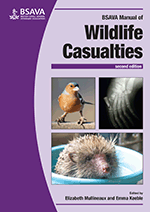
Full text loading...

Small birds, especially young birds of the common peri-domestic species, form a significant proportion of the total number of wildlife casualties presented at rehabilitation units in Britain. Species covered include passerines and allied orders, including cuckoos, swifts, kingfishers and woodpeckers. This chapter covers: ecology and biology; anatomy and physiology; capture, handling and transportation; clinical assessment; first aid and hospitalization; anaesthesia and analgesia; specific conditions; therapeutics; husbandry; rearing of chicks; rehabilitation and release; and legal considerations.
Passerines and other small birds, Page 1 of 1
< Previous page | Next page > /docserver/preview/fulltext/10.22233/9781910443316/9781910443316.30-1.gif

Full text loading...










